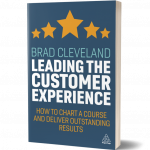When it comes to customer advocacy, there are important aspects of equipping your organization to act within and across functions. The following is a self-assessment.  Depending on where your organization is in this process, some may seem underdeveloped or out of reach, at least in the near term. Customer advocacy is not all or nothing, and you can begin to put it to use in any environment. But these are the things required to optimize an organization-wide approach.
Depending on where your organization is in this process, some may seem underdeveloped or out of reach, at least in the near term. Customer advocacy is not all or nothing, and you can begin to put it to use in any environment. But these are the things required to optimize an organization-wide approach.
1. Customer-focused vision. You have a customer-focused vision. And you truly live it. An example I particularly like is REI’s mission: “To inspire, educate and outfit for a lifetime of outdoor adventure and stewardship.”
2. Customer-focused strategy. When implemented as an organization, customer advocacy means a different business model, one where you put your customers’ interests at the center of decision making. Broadly speaking, product-focused organizations start with products and services and seek customers for them. A customer-focused organization begins with customers in mind and creates solutions for them. As Steve Jobs illustrated when he returned to Apple and turned the company around, this can mean a dramatic shift in priorities.
3. Support of senior leadership. As you are probably already seeing, the support of senior-level leadership is key. Your leadership facilitates customer advocacy through cross-functional collaboration, establishing priorities, and reinforcing the goals of customer advocacy.
4. Customer-focused goals and metrics. Wells Fargo ran into a world of trouble from goals and incentives they set around increasing the average number of accounts per client. It was later discovered that employees had opened millions of accounts on behalf of clients who didn’t need or want them. In hindsight, better objectives would have centered around areas that boost loyalty, which would have organically led to more business with clients. (This is a culture change Wells Fargo is making—as a long-time customer I can see the difference.)
5. Cross-functional collaboration. Cross-functional collaboration is essential to customer advocacy—and, more broadly, to customer experience. Look for processes that support collaboration, effective communication tools, and compatible objectives that roll up to an overall focus on customers.
6. Service level agreements (SLAs). An important ingredient in collaboration is to establish expectations for internal response. You can get as formal and specific as needed. Internal SLAs underscore the importance of responsiveness and ensure that interdepartmental resources are anticipated and available as needed.
7. Engagement with promoters. Customer advocacy is built on a cultural recognition of the enormous value of customers who are brand advocates. From a practical sense, this involves identifying them, highlighting their successes, and engaging with them as appropriate. This is often a function that resides within marketing. But you’ll want to make sure it’s a seamless aspect of your overall approach to customer experience.
Customer advocacy tends to flourish in organizations with all seven of these characteristics in place. In fact, it becomes a driving force. As Amazon.com founder Jeff Bezos put it, “We see our customers as invited guests to a party, and we are the hosts. It’s our job every day to make every important aspect of the customer experience a little bit better.” At their heart, these steps are about alignment: aligning your mission, strategy, resources and focus around doing what’s best for customers. Together, they create a powerful platform for taking action.
Excerpt from Leading the Customer Experience: How to Chart a Course and Deliver Outstanding Results by Brad Cleveland.
